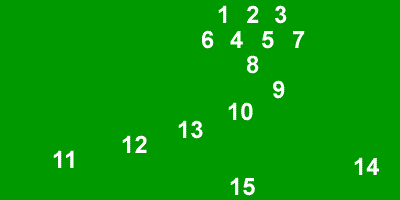Understanding the Positions of Rugby
Orginally rugby teams consisted of 20 players (17 forwards and 3 full backs). Their sole job was to maintain possession if the opposition managed to hack it out of the scrum. The first internationals to play twenty a side was Scotland vs. England in 1871. Around 1875, 1876, the number of players in a team was reduced to 15 (10 forwards and 5 backs). This was done after Oxford persuaded Cambridge to play the varsity match with just 15 players. The move was such a great success it opened up the space in which to run the ball. Most games played 15 players in 1876, first international with 15 was in 1877 which was England vs. Ireland.
Player names, positions, and numbers are worn on the jerseys/shirts. The practice of showing the player's number on the shirt/jersey started in 1897 when New Zealand played Queens in Brisbane (New Zealand's first match tour). The players have the following positions names and numbers:
Forwards/Pack
1. Prop (Loose Head)
2. Hooker
3. Prop (Tight Head)
4. Lock
5. Lock
6. Flanker
7. Flanker
8. Number 8/8-Man
Backs/Lines
9. Scrum Half
10. Outside Half/Stand Half/Fly Half
11. Left Wing
12. Left Centre/Inside Centre
13. Right Centre/Outside Centre
14. Right Wing
15. Full Back
In some Countries the term halfback refers solely to the scrum half, while in other countries it applies to both the scrum half and the fly half. Our CSC Women's Team refers to just the scrum half.
Here is a diagram where players will normally line up at a scrum. Where you see the numbers "1, 2, 3" is where the other team will lock for a scrum down. The backs will match up with each other, so the 14 will be across this 14, the 13 across this 13 and so on.
Numbering & Lettering
After New Zealand started wearing the player's number on the shirt/jersey in 1897, it didn't catch on in England until 1922, and other countries didn't adopt it until much later. Strangely after the fact the views/feedback of the players were against it and they removed them. It was re-introduced in 1933. In 1950 all the home nations used numbers but England, Scotland and Whales numbered the players starting from the full back as #1. France and Ireland did the reverse with fullback being #15. In 1960 it was agreed to do the system like France/Ireland. Some clubs and international's sides used letters instead of numbers. Some club traditions used special labeling schemes for a number of years. Bath and Richmond used a scheme with no #13. West Hartlepool hung up #5 jersey in memory of their, Lock John How. He died of a heart condition in a 1994 league match. English Premiership sides have ceased using the special labeling schemes to better help those new to the sport understand it. Today's system was standardized by the International Rugby Board (IRB). The numbering scheme is 1-15 and the replacements 16 onwards. #1 being the loosehead prop and #15 being the full back.

